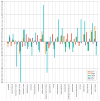Shared genetic risk between corticobasal degeneration, progressive supranuclear palsy, and frontotemporal dementia
- PMID: 28271184
- PMCID: PMC5429027
- DOI: 10.1007/s00401-017-1693-y
Shared genetic risk between corticobasal degeneration, progressive supranuclear palsy, and frontotemporal dementia
Abstract
Corticobasal degeneration (CBD), progressive supranuclear palsy (PSP) and a subset of frontotemporal dementia (FTD) are neurodegenerative disorders characterized by tau inclusions in neurons and glia (tauopathies). Although clinical, pathological and genetic evidence suggests overlapping pathobiology between CBD, PSP, and FTD, the relationship between these disorders is still not well understood. Using summary statistics (odds ratios and p values) from large genome-wide association studies (total n = 14,286 cases and controls) and recently established genetic methods, we investigated the genetic overlap between CBD and PSP and CBD and FTD. We found up to 800-fold enrichment of genetic risk in CBD across different levels of significance for PSP or FTD. In addition to NSF (tagging the MAPT H1 haplotype), we observed that SNPs in or near MOBP, CXCR4, EGFR, and GLDC showed significant genetic overlap between CBD and PSP, whereas only SNPs tagging the MAPT haplotype overlapped between CBD and FTD. The risk alleles of the shared SNPs were associated with expression changes in cis-genes. Evaluating transcriptome levels across adult human brains, we found a unique neuroanatomic gene expression signature for each of the five overlapping gene loci (omnibus ANOVA p < 2.0 × 10-16). Functionally, we found that these shared risk genes were associated with protein interaction and gene co-expression networks and showed enrichment for several neurodevelopmental pathways. Our findings suggest: (1) novel genetic overlap between CBD and PSP beyond the MAPT locus; (2) strong ties between CBD and FTD through the MAPT clade, and (3) unique combinations of overlapping genes that may, in part, influence selective regional or neuronal vulnerability observed in specific tauopathies.
Figures






References
Publication types
MeSH terms
Substances
Grants and funding
LinkOut - more resources
Full Text Sources
Other Literature Sources
Medical
Research Materials
Miscellaneous

